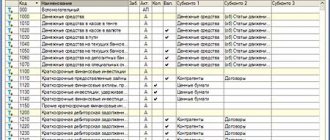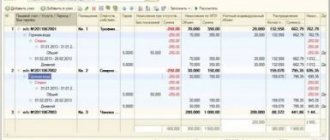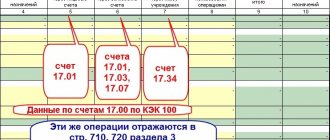Primary accounting documents
Part 7 of Article 9 of the Federal Law of December 6, 2011 No. 402-FZ “On Accounting” allows for corrections in primary accounting documents with the proviso: “unless otherwise established by federal laws or regulatory legal acts of state accounting regulatory bodies.”
Which primary documents are not corrected?
First, let's figure out which primary documents cannot be corrected.
Firstly, cash documents - incoming and outgoing cash orders are not subject to correction (clause 4.1, clause 4.7 of Bank of Russia Directive No. 3210-U dated March 11, 2014 “On the procedure for conducting cash transactions by legal entities and the simplified procedure for conducting cash transactions by individual entrepreneurs and small businesses"). Other documents created in the process of conducting cash transactions (for example, a cash book) can be corrected.
In addition to cash orders, it is unacceptable to correct strict reporting forms. Clause 10 of the Decree of the Government of the Russian Federation dated May 6, 2008 No. 359 “On the procedure for making cash payments and (or) payments using payment cards without the use of cash register equipment” states: the document form must be filled out clearly and legibly, corrections are not allowed. A damaged or incorrectly filled out BSO is crossed out and attached to the document form book for the day on which they were filled out.
Finally, errors are not allowed in banking documents (clause 16 of the Regulations on accounting and financial reporting in the Russian Federation, approved by Order of the Ministry of Finance of Russia dated July 29, 1998 No. 34n). Thus, the bank will perceive a correction in a payment order as a violation of the integrity of the order to transfer funds. An order with such a defect is not subject to execution (clauses 2.1.–2.4 of the Regulations on the rules for the transfer of funds, approved by the Bank of Russia on June 19, 2012 No. 383-P).
Document "Operation"
Let's look at how you can work with registers using the “Operation” document.
Let's assume the user enters the accounting entry "Manual Transaction" and does not take into account the movements in the registers. Let's take an example - correction of payroll. Let me make a reservation right away that such operations must be carried out in the payroll document. We do this as an example to show how the registers work. By posting we reduce payroll.
Fig. 10 Working with registers using the “Operation” document
Having generated the “Account Card” report (menu section “Reports” - “Standard”) for the employee, we see that our adjustments are made according to the accounting entries. Reducing by 200 rubles. the amount of the salary, we have accrued 21,460 rubles. (RUB 21,660 -RUB 200).
Fig. 11 “Account Card” report for an employee
The turnover is going on, the user is happy, but for the time being. Looking ahead, for example, let’s generate a report “2-NDFL for transfer to the Federal Tax Service” for an employee. (Menu section “Reports” - “Regulated reports”). From the report we see that the amount of income for December did not change. This situation arose because we did not have any movements in the registers that are provided for filling out reports, and our accounting operation did not affect the reports in any way.
Fig. 12 The amount of income for December did not change
Let's return to our document "Operation". Click on the “More” button and select the “Select registers” item.
Fig.13 Register selection
In the list that opens, select the “Income accounting for personal income tax calculation” register.
Fig. 14 Income accounting for calculating personal income tax
In our “Operation” document, another tab appears with the name of the selected register, where we add an entry, filling in the necessary data.
Fig.15 Tab with the name of the selected register
Using the “Operation” document, we adjust this register. There are more registers involved in the payroll operation, but we show how the document works using the example of one register.
Let’s check how the adjustment to the “Income Accounting for the Calculation of Personal Income Tax” register affected the report. Let’s generate the “2-NDFL for transfer to the Federal Tax Service” report again and see that the amount of income on the line for the 12th month has changed by 200 rubles, thanks to the register adjustment.
Fig. 16 Report “2-NDFL for transfer to the Federal Tax Service”
This example shows us that reports are filled out based on register entries, and simply correcting an accounting entry with the document “Operation entered manually” is not enough. If necessary, adjustments to the accumulation register entries can be made using the same document by selecting the desired register.
Invoices
The procedure for correcting invoices is determined by Decree of the Government of the Russian Federation dated December 26, 2011 No. 1137 “On the forms and rules for filling out (maintaining) documents used in calculations of value added tax” (clause 7 of Section II of Appendix No. 1).
Depending on the nature of the error, you will either have to create a new invoice - a corrective one - or make corrections to the existing one. If errors are detected in invoices that do not prevent the tax authorities from identifying the seller, buyer of goods (work, services), property rights, the name of the goods (work, services), property rights, their value, as well as the tax rate and the amount of tax presented to the buyer, new copies of invoices are not prepared. The invoice with amendments made to it is signed by the head and chief accountant of the organization or other duly authorized persons.
For example, if the name of the product being sold is incorrectly indicated on the invoice, then a new invoice must be drawn up. Otherwise, the taxpayer loses the right to deduct VAT (letter of the Ministry of Finance of Russia dated August 14, 2015 No. 03-03-06/1/47252).
Registers generated by the “Infobase Collapse” processing
I would like to briefly mention another way to adjust registers. With large volumes of work, the 1C program can be heavily overloaded, and it becomes necessary to restore order, including in the registers. The “Information Base Reduction” processing allows you to generate register balances for a specific date.
Fig. 21 Information base collapse
We will not dwell on it in detail, but we will mention that as a result of this operation, records with balances by register are formed in the “Operations entered manually” journal, and if necessary, the user can correct or delete them.
Fig. 22 Records with balances broken down by registers
The entire operation of the program is based on writing to registers, so the user needs to understand the principle of their operation, how writing to registers occurs, and how to correct them correctly if necessary. Incorrect adjustments will affect the reliability of the information, and therefore errors may occur when generating reports. If you have any questions, our specialists will be happy to advise you and select the optimal tariffs and prices for 1C support.
Accounting registers
Corrections in the accounting register that are not authorized by the persons responsible for maintaining the specified register are not allowed. A correction in the accounting register must contain the date of the correction, as well as the signatures of the persons responsible for maintaining this register, indicating their surnames and initials or other details necessary to identify these persons.
PS In general, only those who do nothing make no mistakes. And to prevent new errors when correcting old ones (depending on the status of the document and the date the error was discovered), the table will help you.
How to and how not to fix it
| Reporting form | How to make corrections | Source |
| VAT return | Errors may not be corrected by correction or other similar means. | Clause 8 of the Procedure for filling out the declaration, approved. by order of the Federal Tax Service of Russia dated October 29, 2014 No. ММВ-7-3/ [email protected] |
| Income tax return | Clause 2.2 of the procedure for filling out the declaration, approved. by order of the Federal Tax Service of Russia dated October 19, 2016 No. ММВ-7-3/ [email protected] | |
| Tax return for corporate property tax | Clause 2.2 of the procedure for filling out the declaration, approved. by order of the Federal Tax Service of Russia dated November 24, 2011 No. ММВ-7-11/895 | |
| Tax return for transport tax | Clause 2.3 of the procedure for filling out the declaration, approved. by order of the Federal Tax Service of Russia dated December 5, 2016 No. ММВ-7-21/ [email protected] | |
| Tax return for tax paid in connection with the application of the simplified taxation system | Clause 2.3 of the procedure for filling out the declaration, approved. by order of the Federal Tax Service of Russia dated February 26, 2016 No. ММВ-7-3/ [email protected] | |
| Tax return for single tax on imputed income for certain types of activities | Clause 2.3 of the procedure for filling out the declaration, approved. by order of the Federal Tax Service of Russia dated July 4, 2014 No. ММВ-7-3/ [email protected] | |
| Calculation of insurance premiums | Clause 2.17 of the Procedure for filling out the calculation, approved. by order of the Federal Tax Service of Russia dated October 10, 2016 No. ММВ-7-11/ [email protected] | |
| Personal income tax return | Corrections in the declaration are not allowed. | Clause 1.2 of the procedure for filling out the declaration, approved. by order of the Federal Tax Service of Russia dated December 24, 2014 No. ММВ-7-11/ [email protected] |
| Calculation of accrued and paid insurance premiums for compulsory social insurance against industrial accidents and occupational diseases, as well as expenses for payment of insurance coverage | To correct errors, you must cross out the incorrect value of the indicator, enter the correct value of the indicator and sign the policyholder or his representative under the correction indicating the date of correction. All corrections are certified by the seal (if any) of the policyholder/legal successor or his representative. Errors may not be corrected by correction or other similar means. | Clause 2 of the Procedure for filling out the calculation form, approved. by order of the FSS of the Russian Federation dated September 26, 2016 No. 381 |
Algorithm for correcting errors in NU
Learn more about correcting errors in tax accounting for income taxes
An error in the current year does not result in an understatement of tax.
According to the 1C algorithm, corrections are made in tax accounting (TA) in the current period according to the rules of paragraph. 3 p. 1 art. 54 Tax Code of the Russian Federation:
- There is no need to open a “closed” period, since transactions in the NU will be generated by the date the error was discovered: in correspondence with accounts and sub-accounts, which are indicated on the Products - as in the primary document;
- in correspondence with accounts and subcontos that are indicated on the Services , or in Dt 90.02 - switch in the section Reflection of income and expenses ;
Read more Workshop on correcting an error in the current year in NU, which does not lead to an understatement of income tax
An error in the current year results in an understatement of tax.
According to the 1C algorithm, corrections are made to the NU in the current period. But this is not true!
If the tax is understated, we must submit an updated declaration for the period the error occurred - for the previous reporting period. Therefore, there are two options for correcting the error.
Option 1. Manually adjusting the posting date in the document NC
- in the transactions of the Receipt Adjustment , select the Manual adjustment ;
- change the posting date in tax accounting to the date the error occurred.
The date changes only for posting income/expenses to NU:
- repeat the Month Closing for the previously closed period; income tax will be calculated automatically.
Advantages of the option:
- all expenses in NU in the period of error will be posted correctly;
- income tax will be recalculated automatically;
- the updated income tax return for the period of error will be automatically filled in by the program.
Disadvantages of the option:
- you will have to re-close the previously closed period.
Learn more Workshop on correcting an error in the current year in NU, which leads to an understatement of income tax, when manually adjusting the entries of the Receipt Adjustment document
Option 2. Manually filling out the updated declaration
When posting the Receipt Adjustment , you do not need to adjust anything:
- we leave the entry for correcting income/expenses in the NU with the date the error was discovered and there is no need to “get into” the NU of the previous period.
Pros of the option
- there is no need to reschedule a previously closed period - everything will remain as it was;
- income tax will be automatically calculated in the correction period.
Disadvantages of the option
- the amount of expenses in NU for the previous reporting period will not be reflected correctly. It will become correct only during the period of correcting the error on an accrual basis;
- an updated income tax return for the period of error will have to be generated manually;
- in the transactions of the Receipt Adjustment , select the Manual adjustment ;
- change the posting date in tax accounting to the date the error occurred.
The date changes only for posting income/expenses to NU. In the BU you need to leave everything as is:
- repeat the Month Closing for a previously closed period: income tax will be calculated automatically.
Read more Workshop on correcting an error in the current year in NU, which leads to an understatement of income tax, when manually filling out an updated declaration
Last year's mistake does not result in underestimation of tax
According to the 1C algorithm, corrections of errors from previous years in 1C are entered into the NU in the current period according to the rules of paragraph. 3 p. 1 art. 54 Tax Code of the Russian Federation.
- There is no need to open the “closed” period, because postings to NU will be generated by the date the error was discovered: in correspondence with account 91;
- article Other income and expenses on the tab Main should be like Profit (loss) of previous years:
Based on the results of the current year, make sure that the declaration shows profit (Letter of the Ministry of Finance of the Russian Federation dated April 13, 2016 N 03-03-06/2/21034), otherwise you cannot use the rules of paragraph 1 of Art. 54 of the Tax Code of the Russian Federation and take into account the error of previous years in the current period. If the declaration turns out to be unprofitable, then the error can be corrected only by submitting an amendment for the previous period.
Read more Workshop on correcting last year’s error in NU, which does not lead to an understatement of income tax
Last year's mistake leads to understatement of tax
According to the 1C algorithm, corrections of errors from previous years in 1C are entered into the NU in the past period:
- it is necessary to open a “closed” period, because postings to NU will be generated by the date of the error;
- in the transactions of the document Adjustment of receipts , select the Manual adjustment : Kt 90.01.1 - increase in the tax base as part of sales income - not correct! It is necessary to adjust the posting in correspondence with accounts 90.02, 90.07, 90.08 (91.02) - there should be an account for current expenses, not revenue.
- Dt 90.09 Kt 99.01.1 – financial result of the adjustment.
The posting to the NU will be made in a “closed” period, but the sequence boundary is not violated - a feature of the Implementation Adjustment document.
In this case, a balance will appear in NU on subaccounts 90 (91) and account 99, which needs to be closed:
- run Balance Sheet Reformation in the Month Closing for December last year;
- additionally charge income tax for the previous year using the document Transaction entered manually by the date the error was discovered - according to accounting rules.
- an updated income tax return will be generated automatically.
Read more Workshop on correcting last year's error in NU, which leads to an understatement of income tax
Signing and saving accounting registers in electronic form
To create an accounting register in electronic form, you must click on the “Accounting register”
and select
“Sign electronic signature and save”
.
To save the accounting register (without signature), you must click on the “Accounting register”
and select
“Save”
, so this register will be electronically placed in the Archive of Accounting Registers, and later it can be printed and signed.
How to adjust accounting registers
You can separately highlight ways to correct errors in accounting documents - registers (books, journals, etc.). Among them, the law names the compilation of:
- canceling entries in accounting accounts (so-called reversal);
- supplementary entries in accounts.
Formally, it is possible to completely replace the register as if it were a new document, but such a need does not arise often (dilapidation, damage, unreadability, etc.).
Of course, permission to correct the accounting register must be given by the specialist who is responsible for maintaining it.
Also see “Organization of document flow in accounting.”
Corrections to labor activity data
All entries in this section must have continuous numbering and be drawn up in strict accordance with the Rules for filling out and maintaining work books. A record of hiring, transfer or dismissal must have a number, a link to the relevant article of labor legislation and details (date, number) of the order.
You need to know: you cannot cross out incorrect entries and enter the correct data at the top in the subsection of the work book that records information about work and rewards .
An error made in job information can be corrected:
- at the place of work where there was an inaccuracy in the design;
- by another employer - on the basis of an official letter from an organization that at one time incorrectly indicated information about the employee’s work activity.
The correct entry is made as follows:
- a record is made from a new line with the last serial number and the date when changes are made;
- the corrective text must contain the number of the entry being changed and indicate that it is invalid;
- The correct entry is made under the next number.
In the 4th column, where the number of the basis order is written, the details of the original order are used. If an order is issued requiring changes to be made to the work book on the basis of a court decision, the number and date of this document are recorded.
You should know: if the last entry in the work book is subject to adjustment, then the personnel employee makes changes to the information about the work under the next serial number. Such a record does not require certification with a signature and seal. The following corrections made after making entries about changes in work activity must be certified by the signature of an authorized person and the seal of the organization.
Corrections to the work book are permitted only on the basis of an official document provided by the organization where the error was made. Often, the question of adjusting employment information is required many years later, when the enterprise has ceased to exist.
In such cases, the employee must contact the legal successor, and in his absence, the human resources department at the last place of work. The current employer will enter the correct information and indicate the details of the original order as the basis.
Changing the name or legal form of an organization
In the section of the work book dedicated to the employee’s work activities, entries about the renaming or reorganization of the employer must be made. Such changes are recorded in column 3, without indicating the number and date of entry. The basis for renaming or changing the legal form of a company is an order for the enterprise, the number and date of which is entered in the work book.






